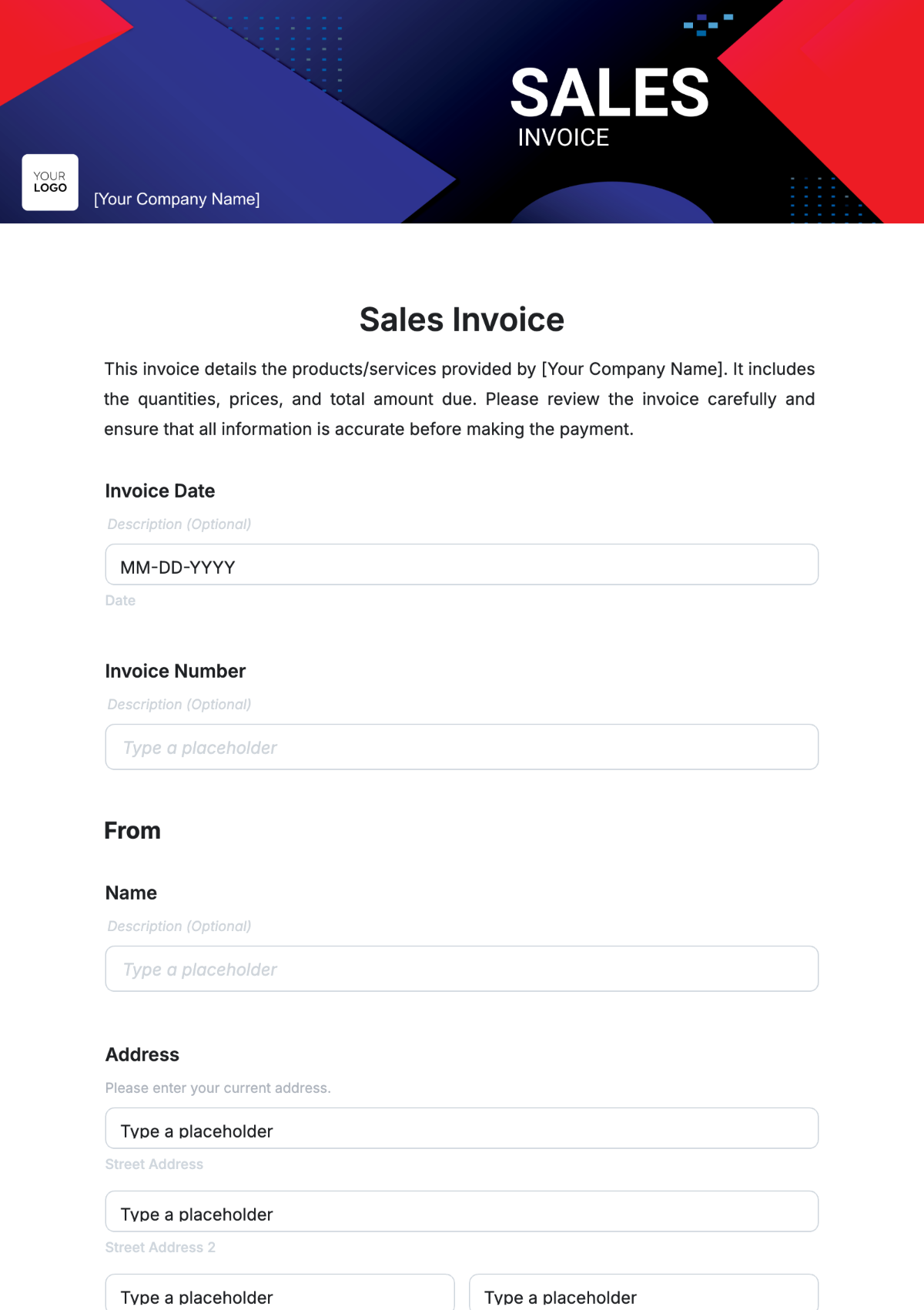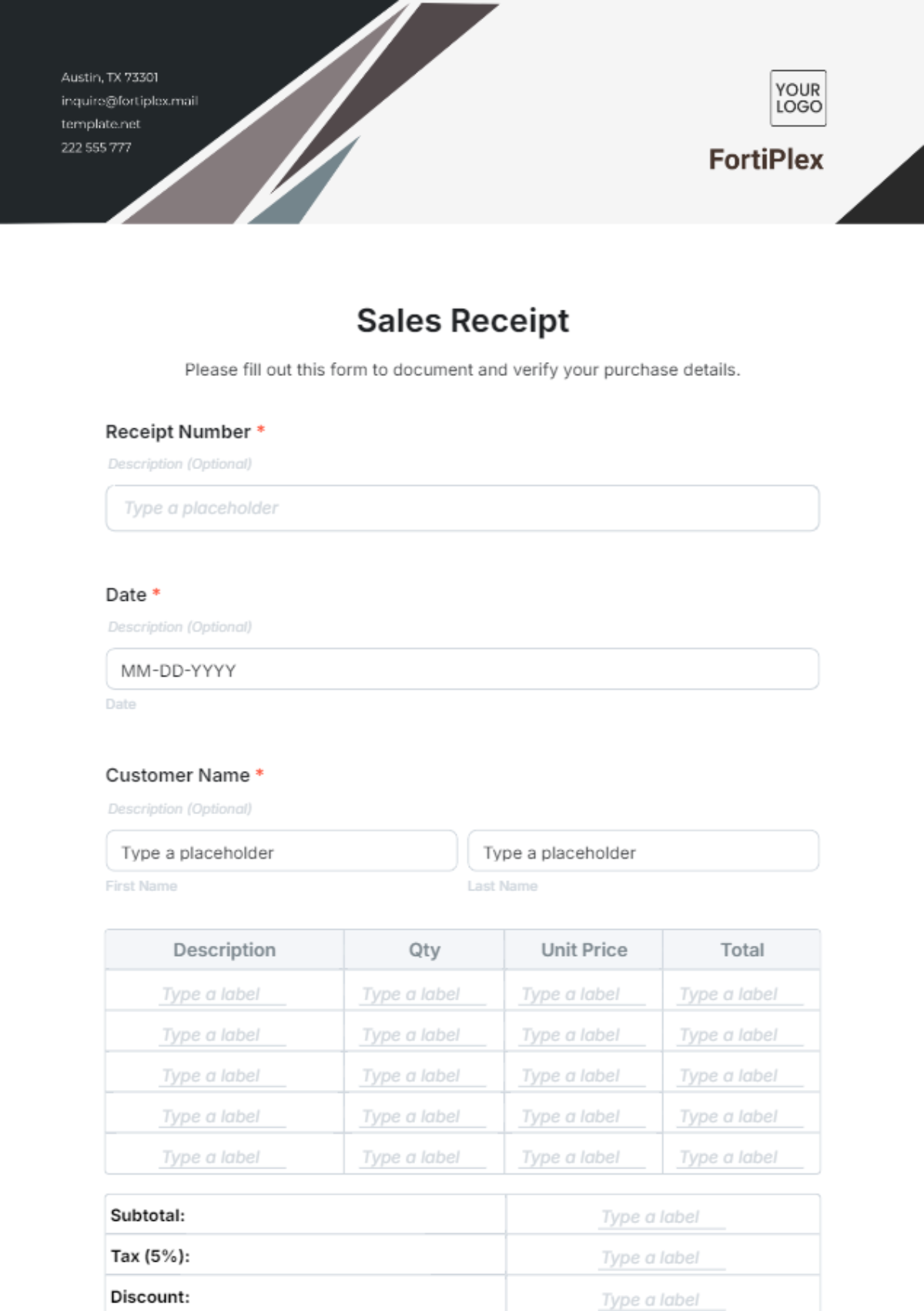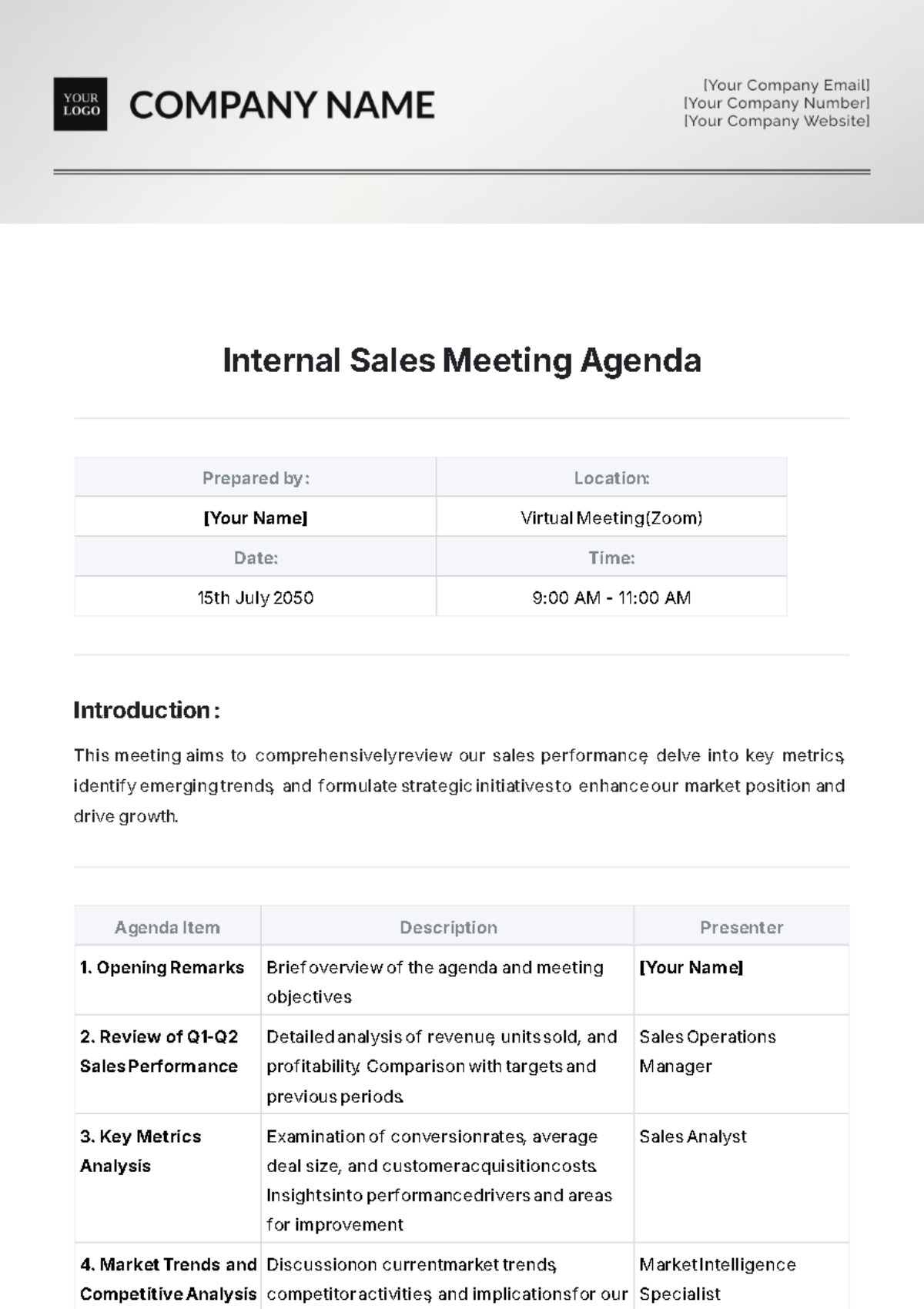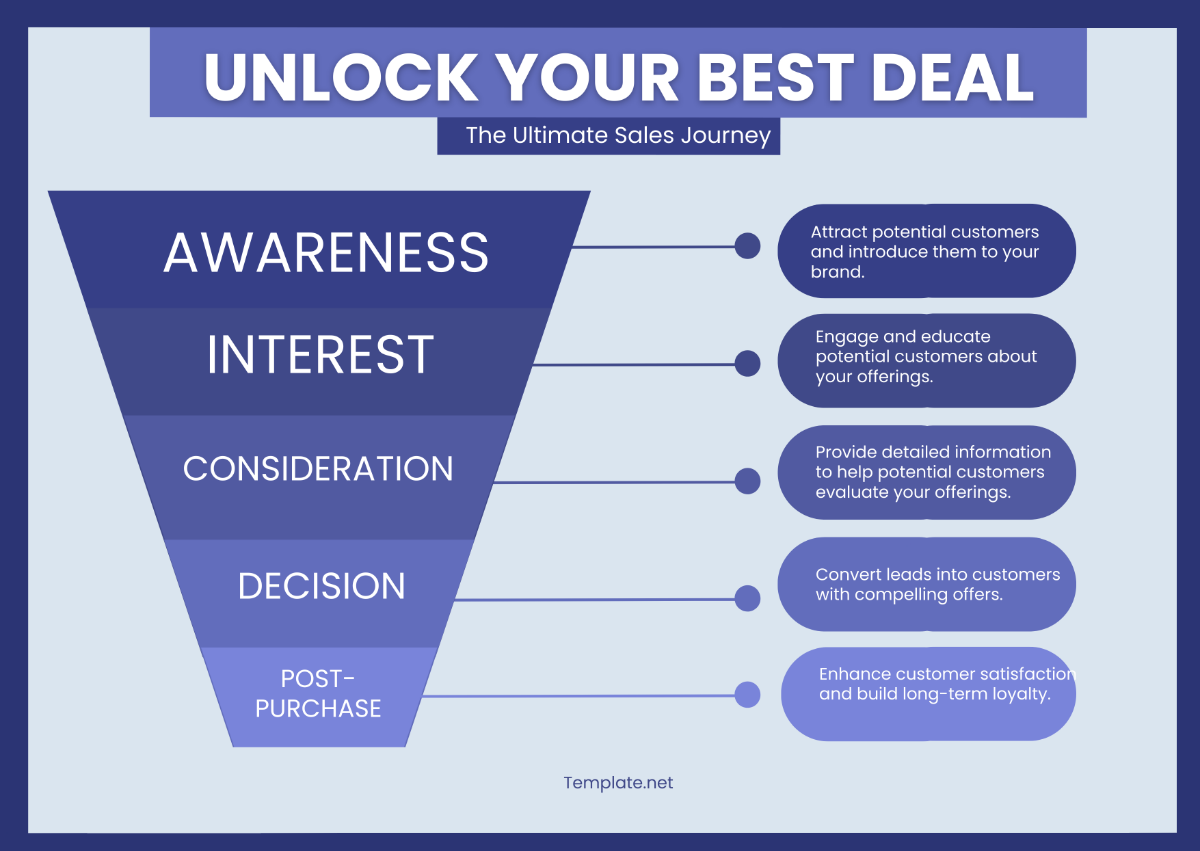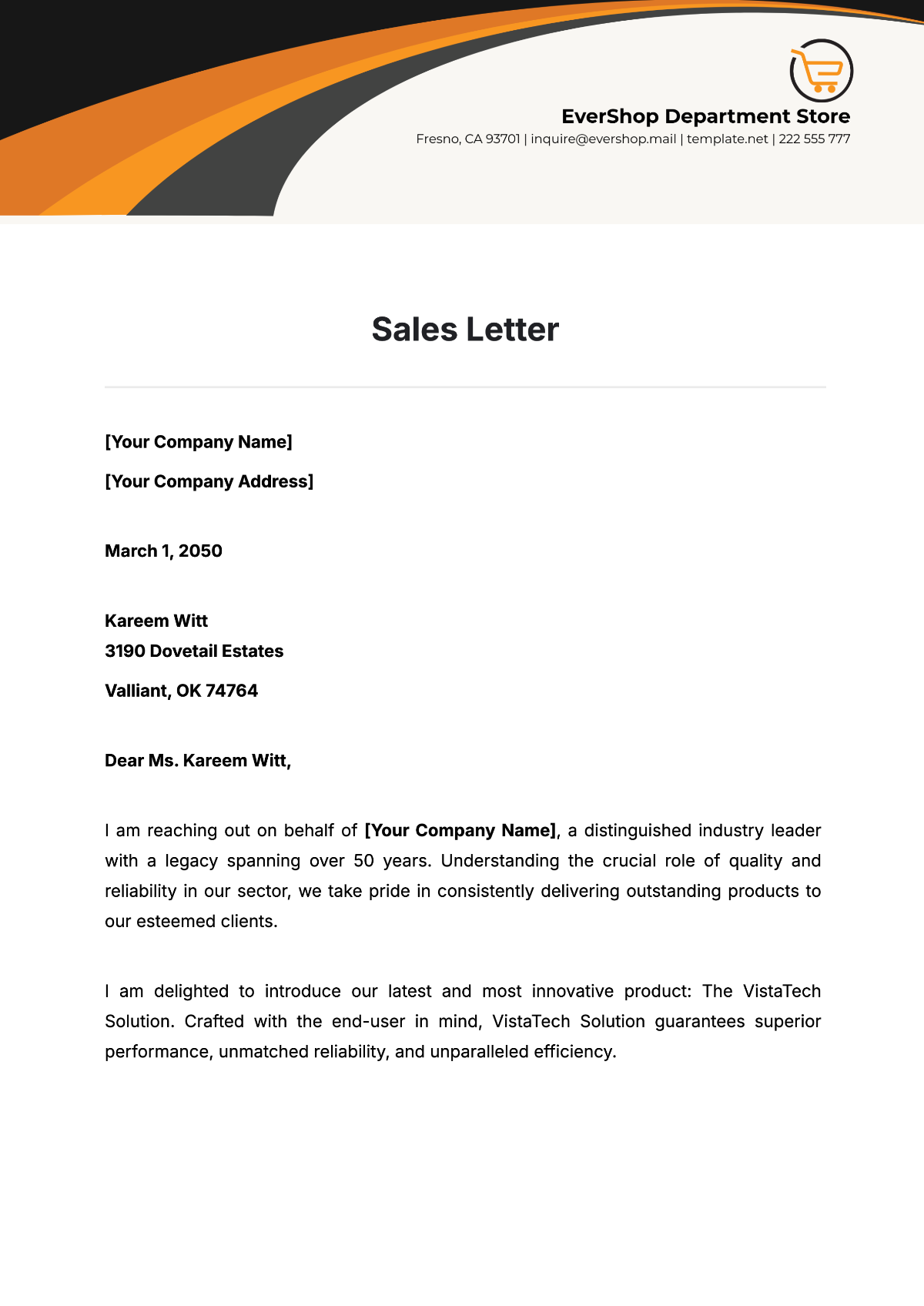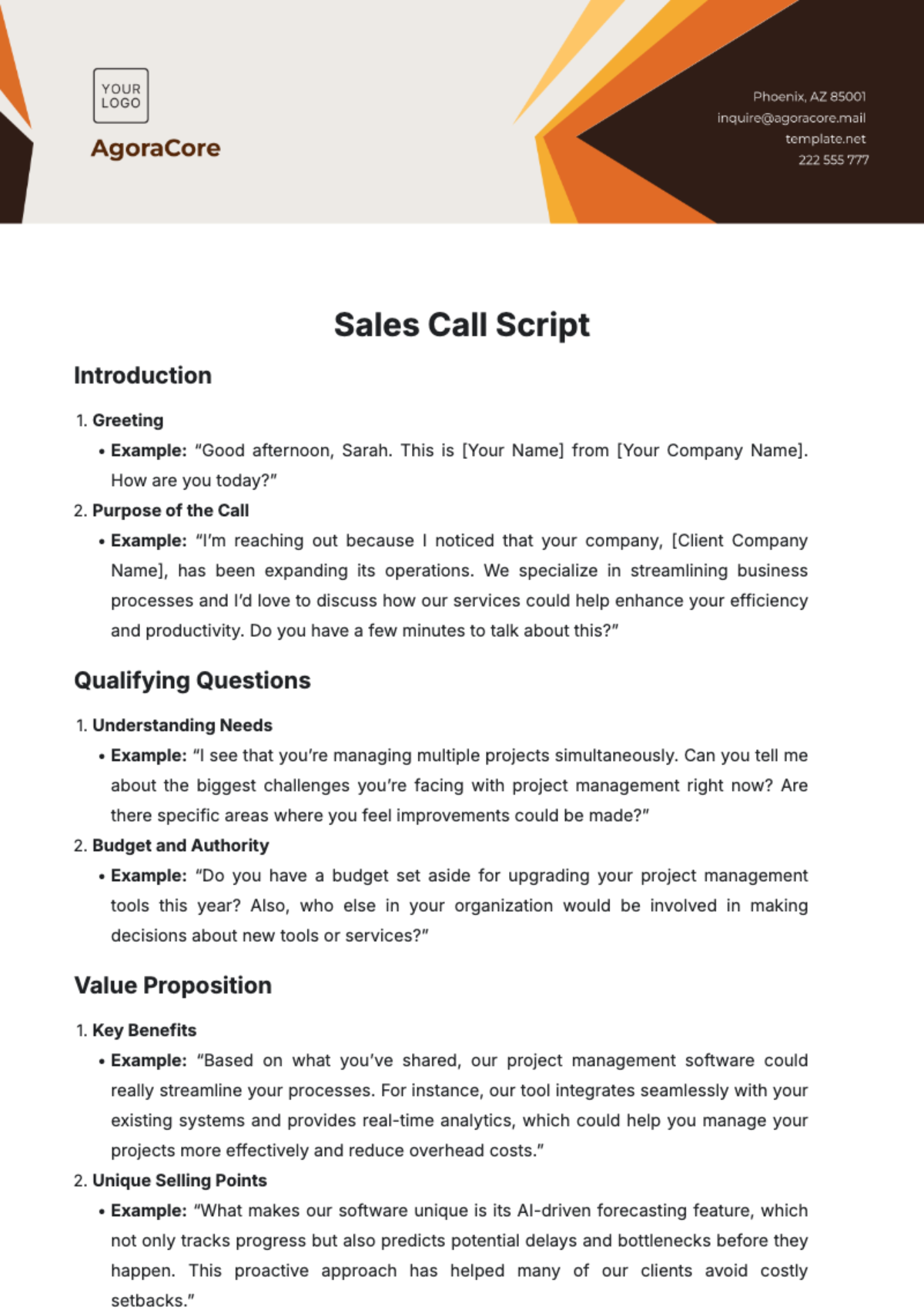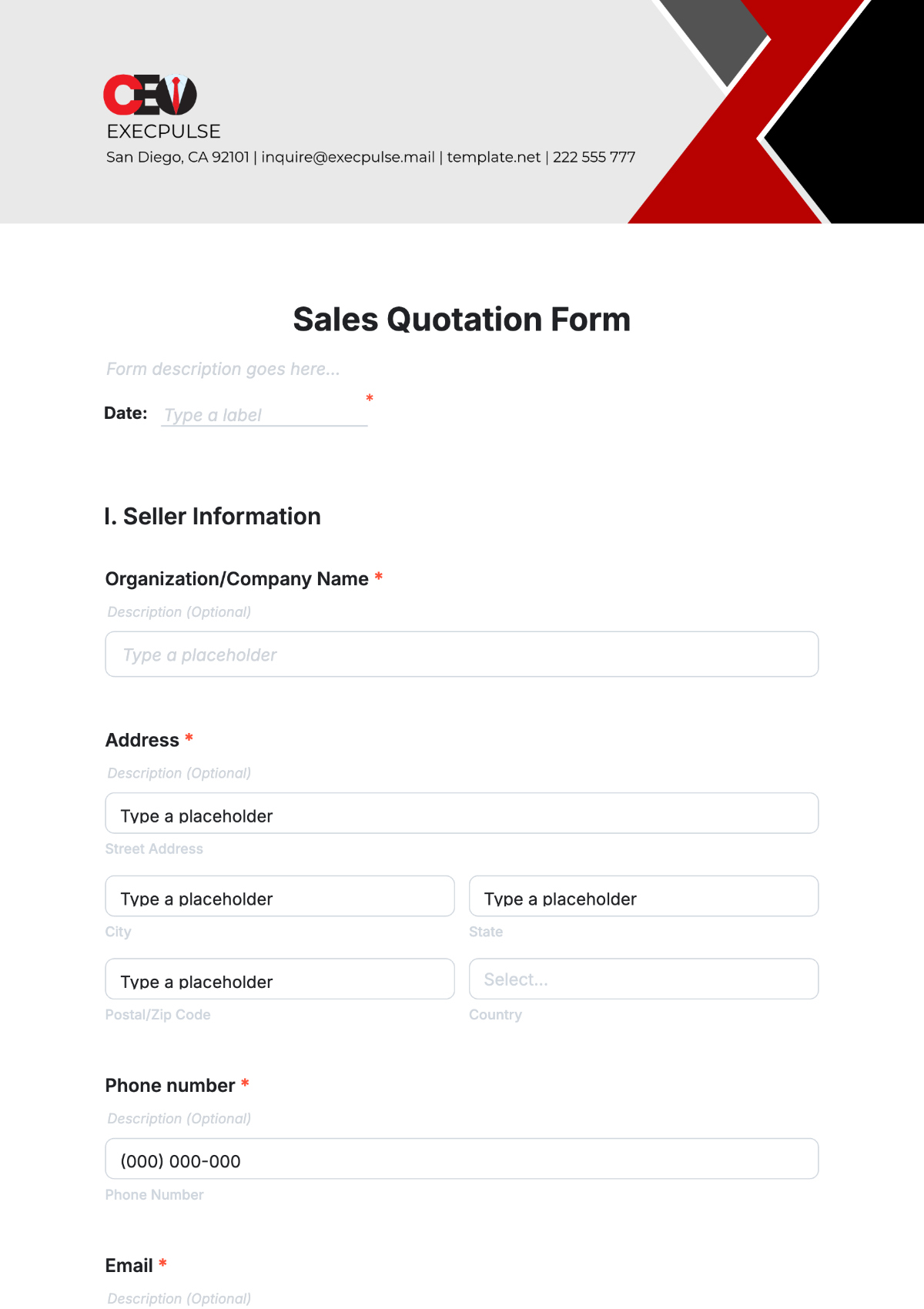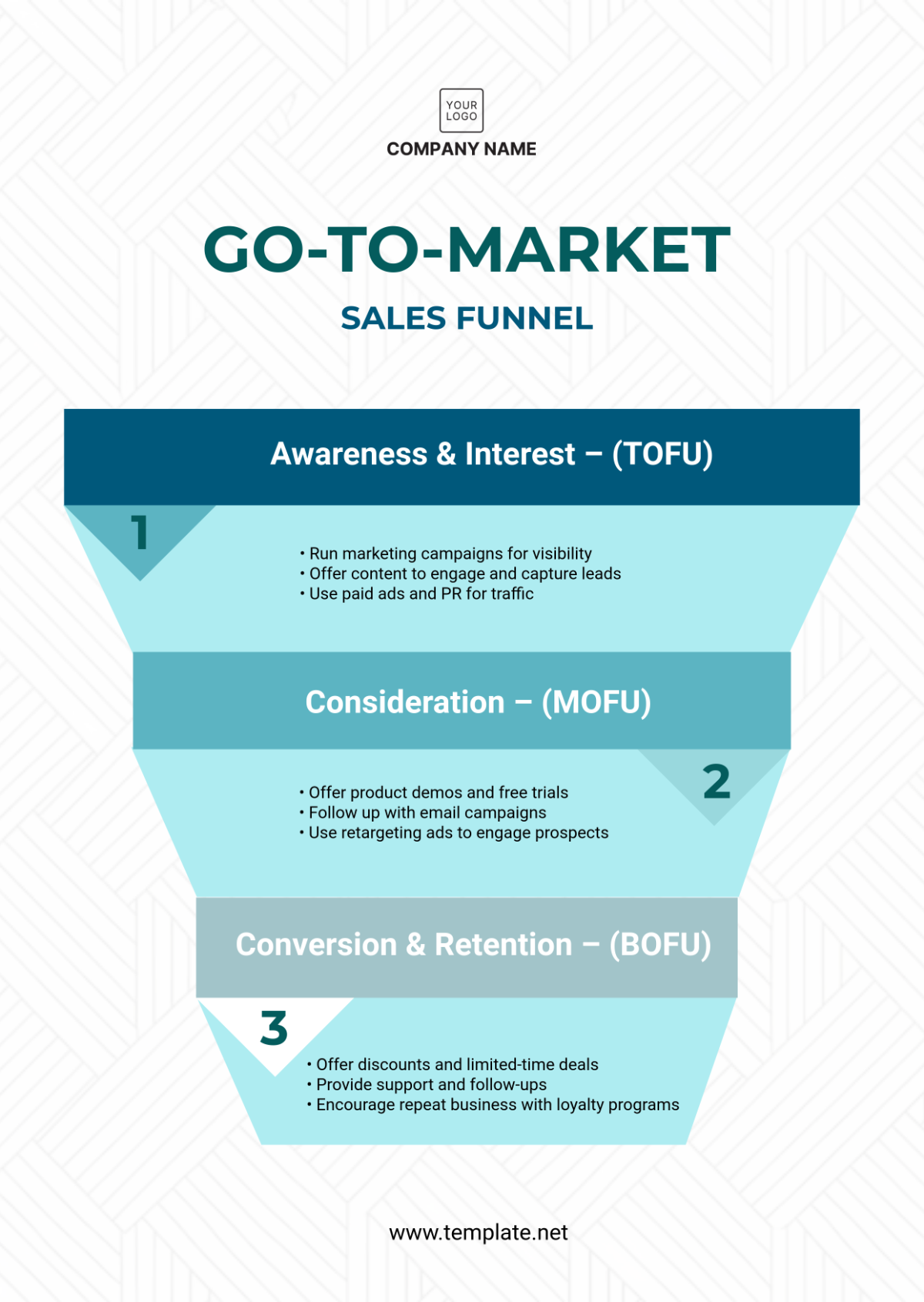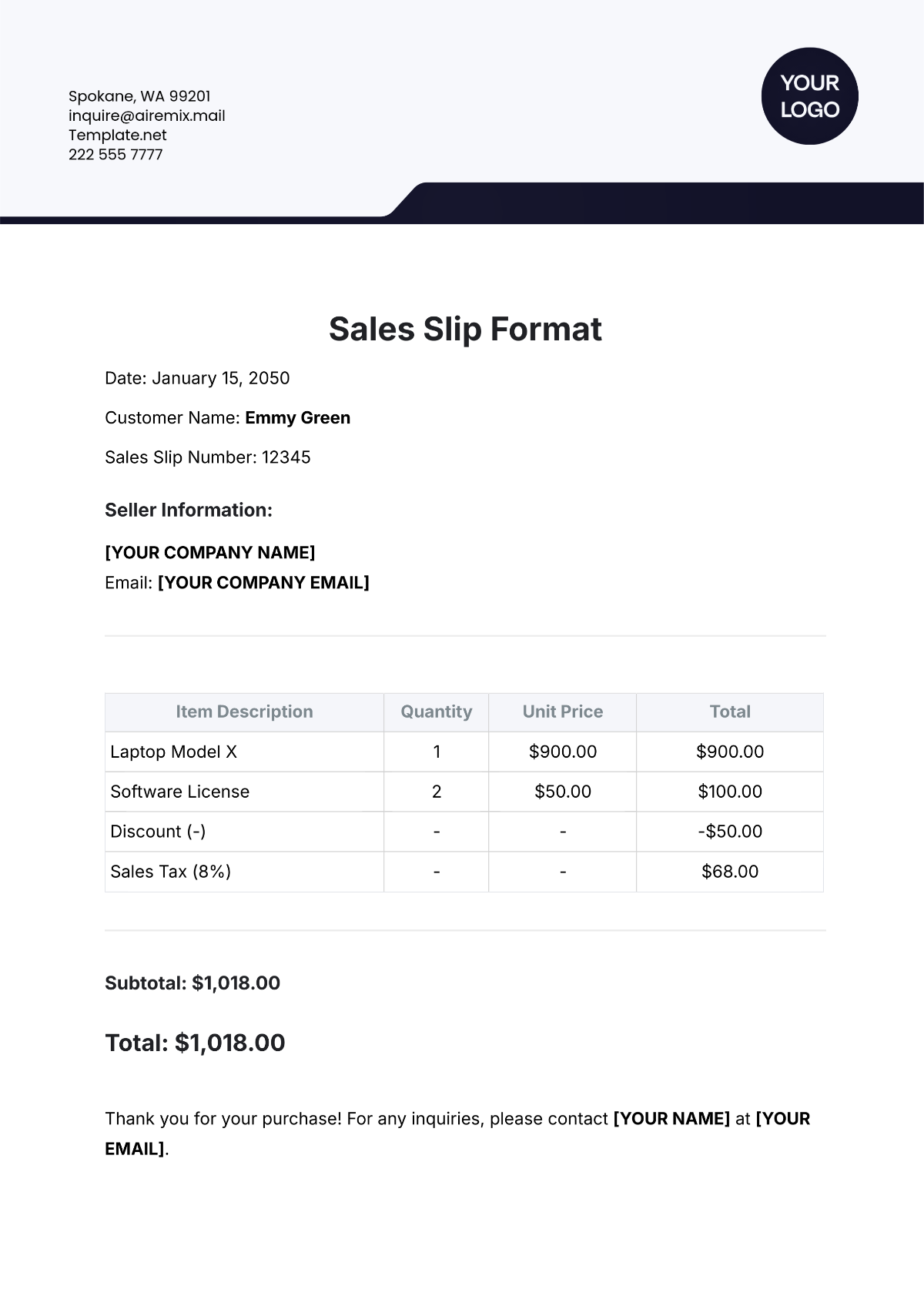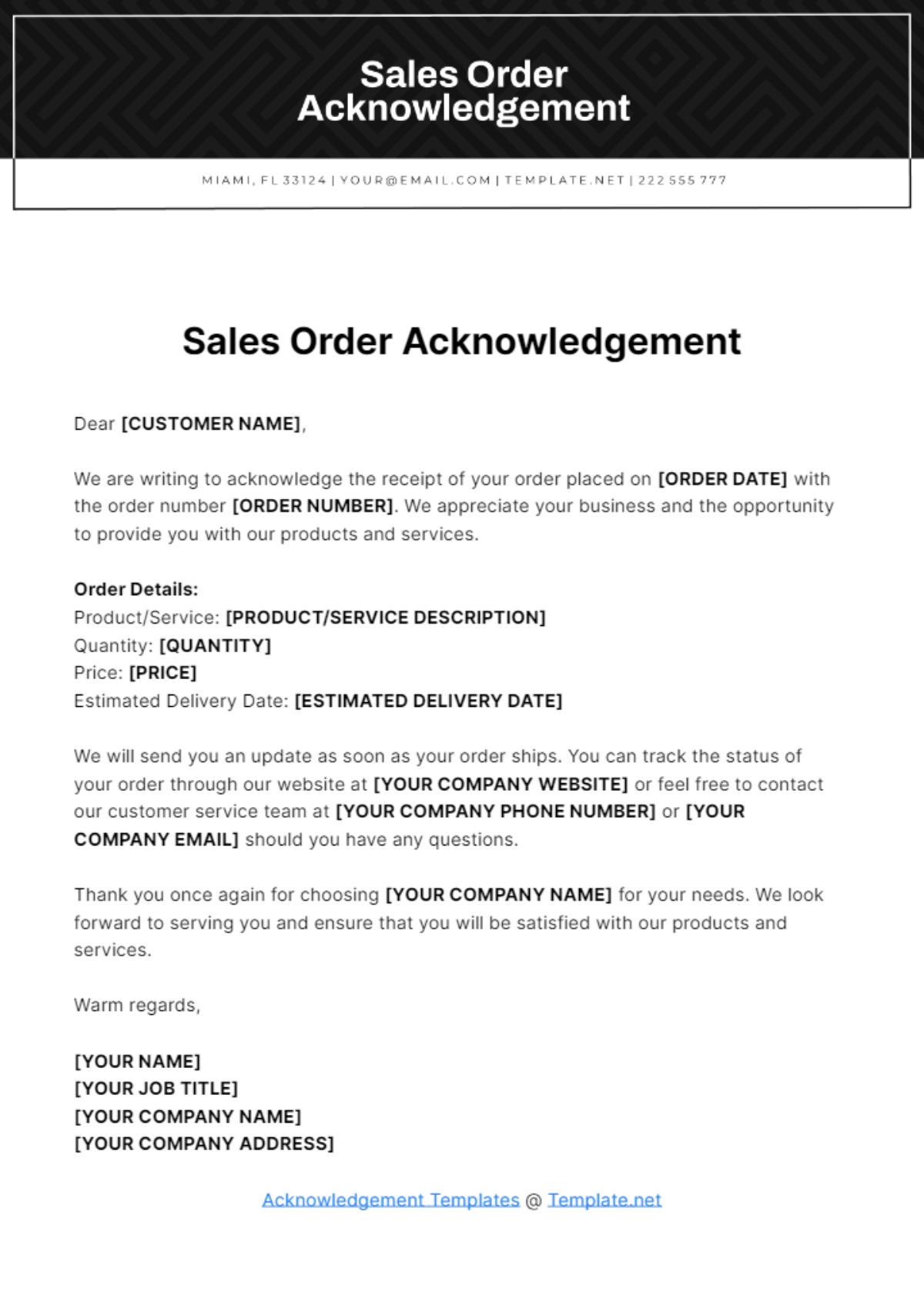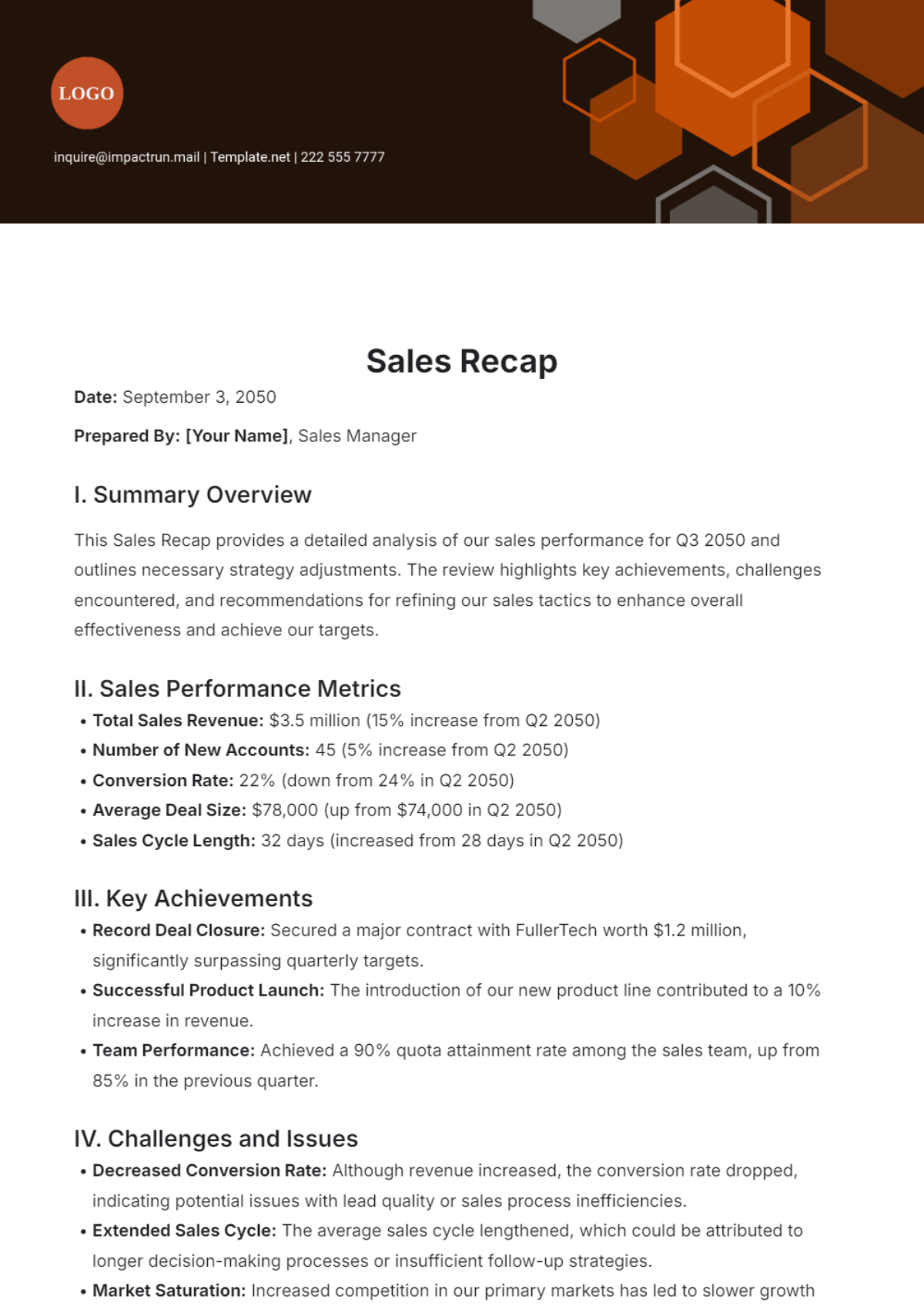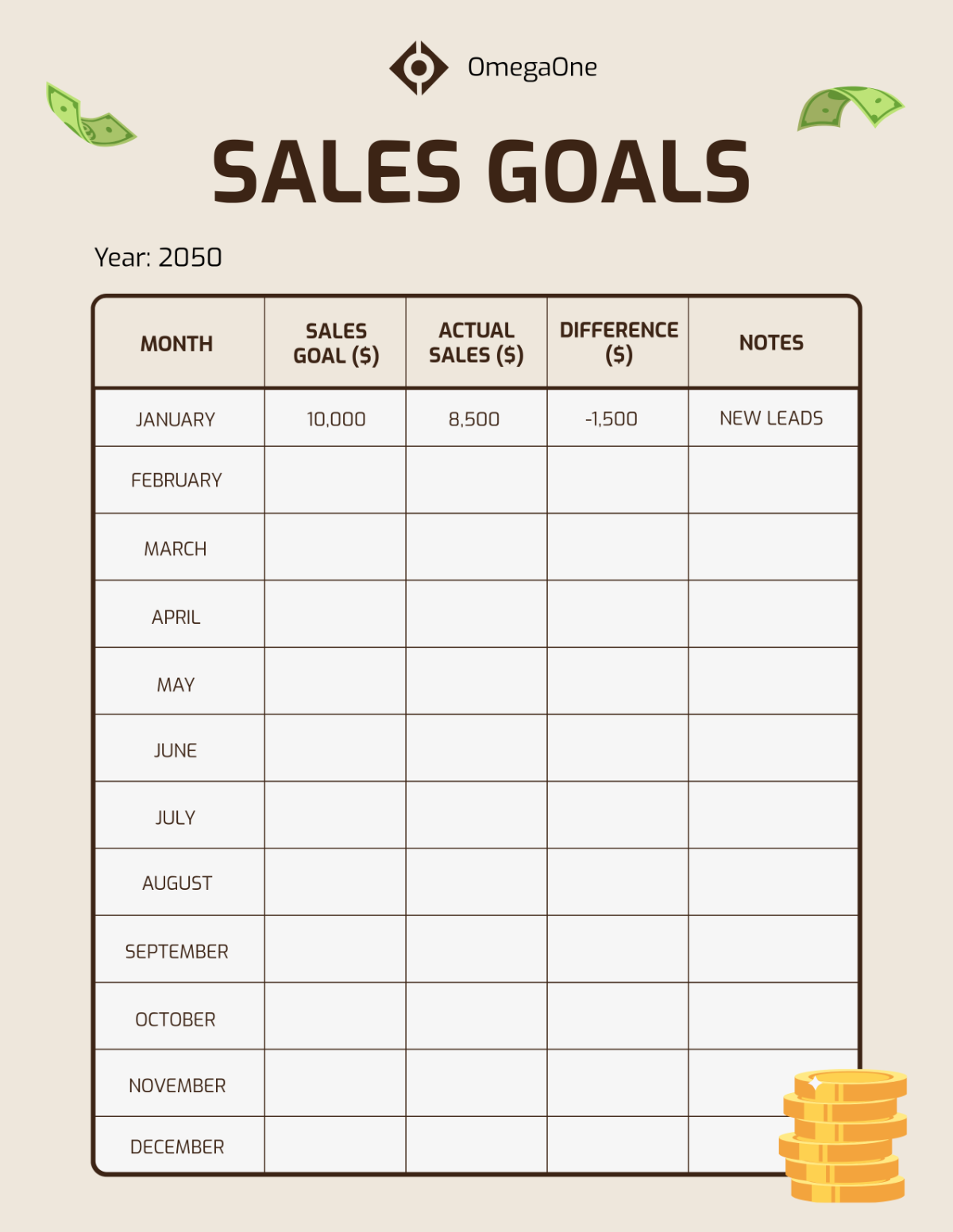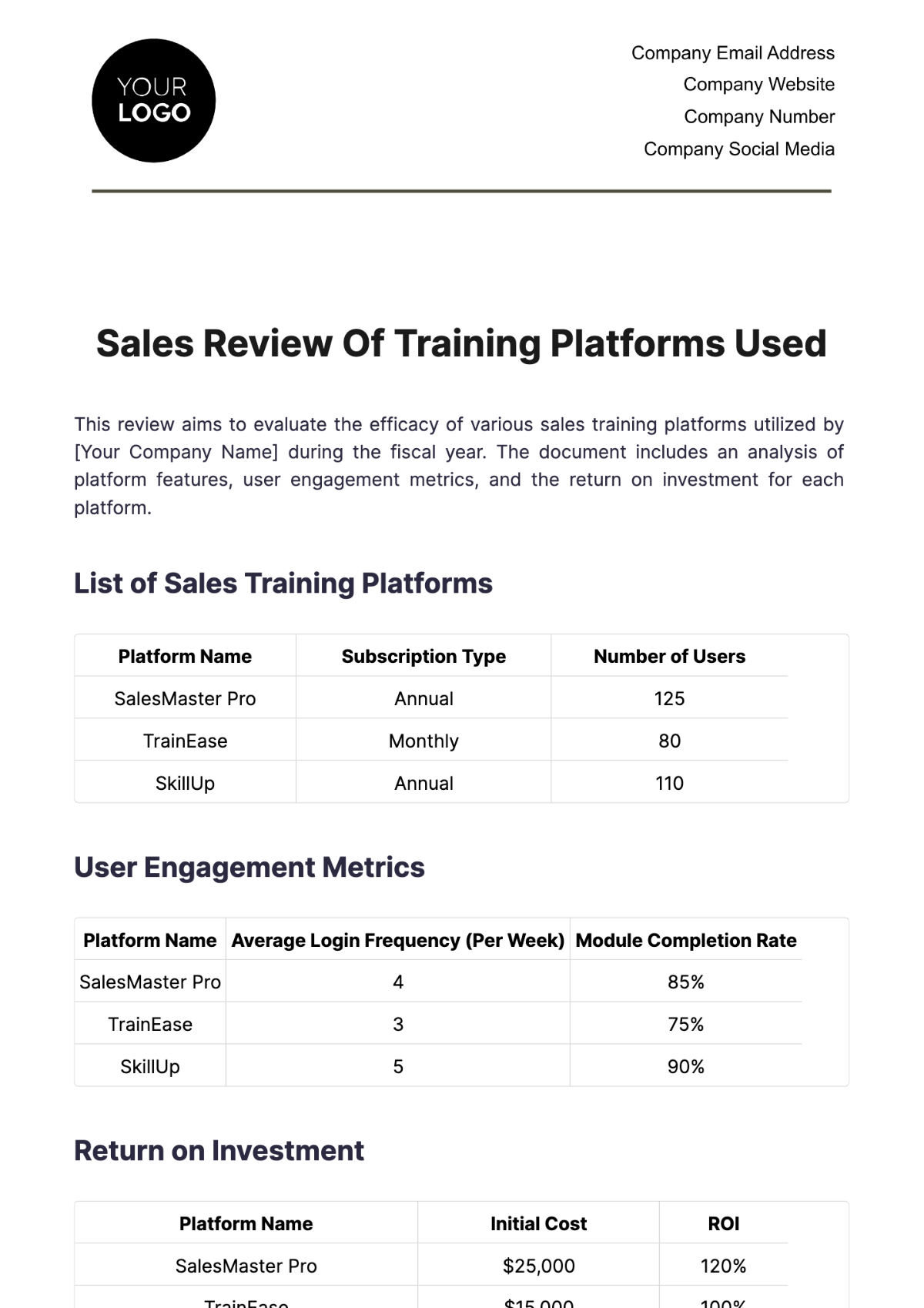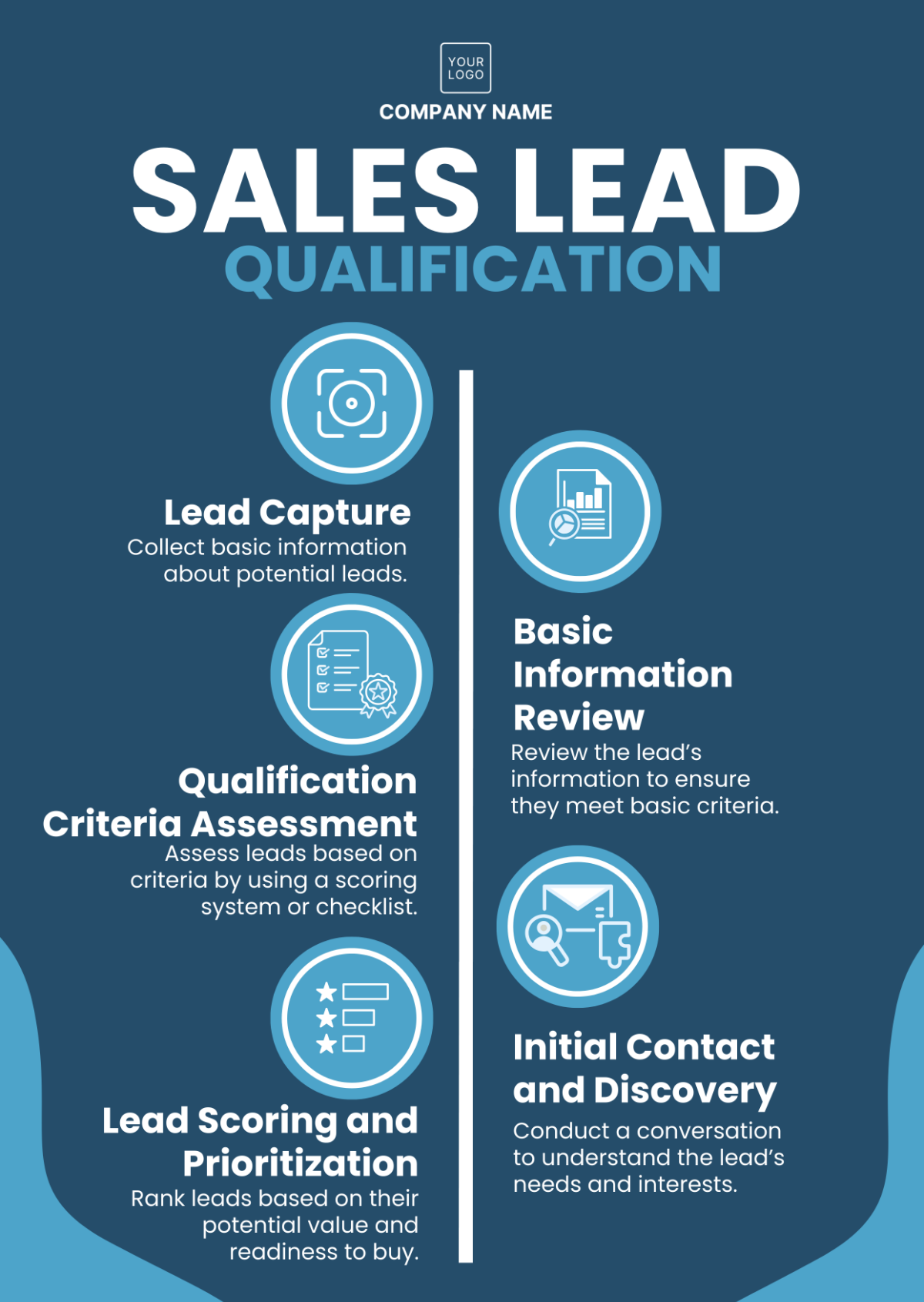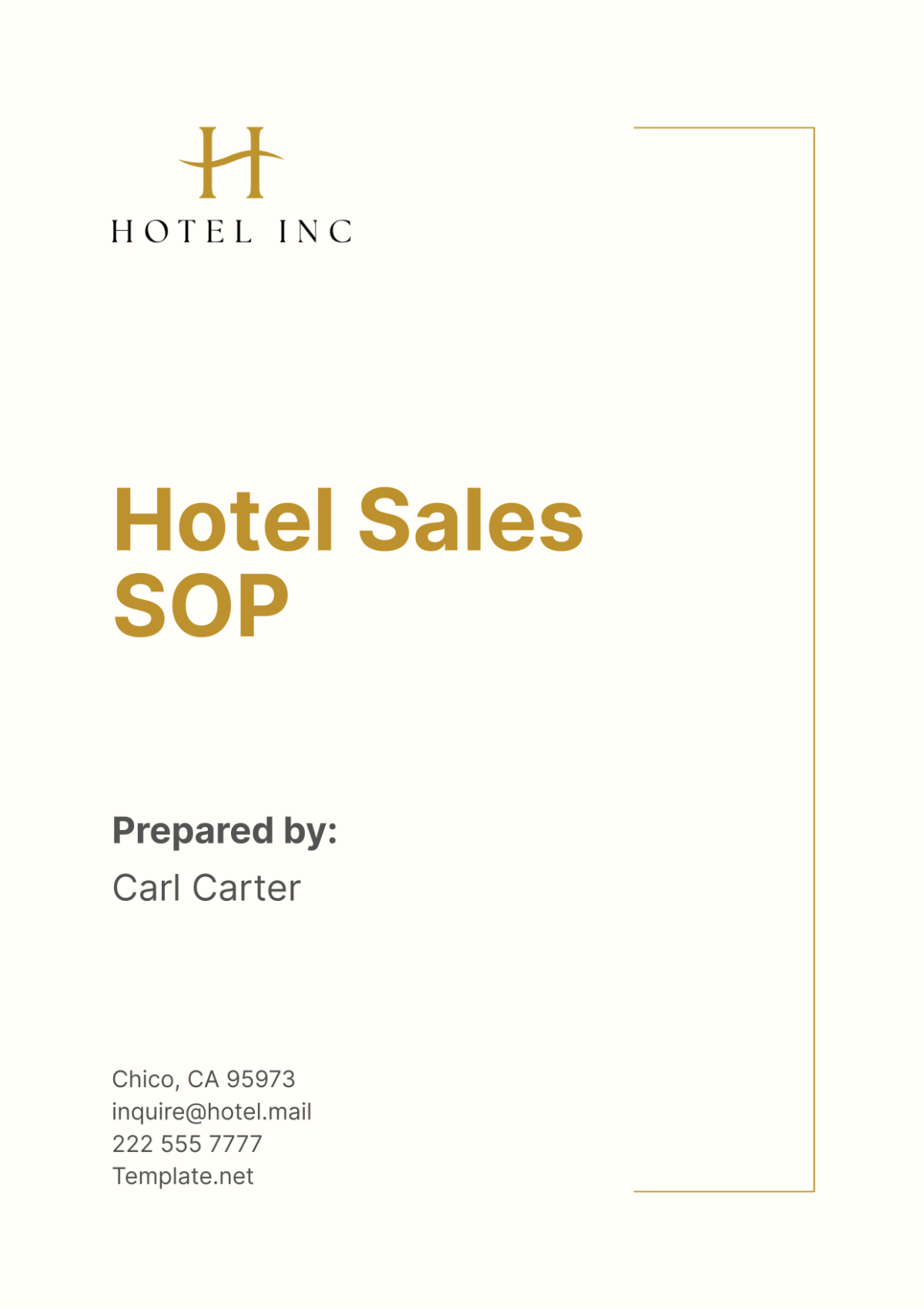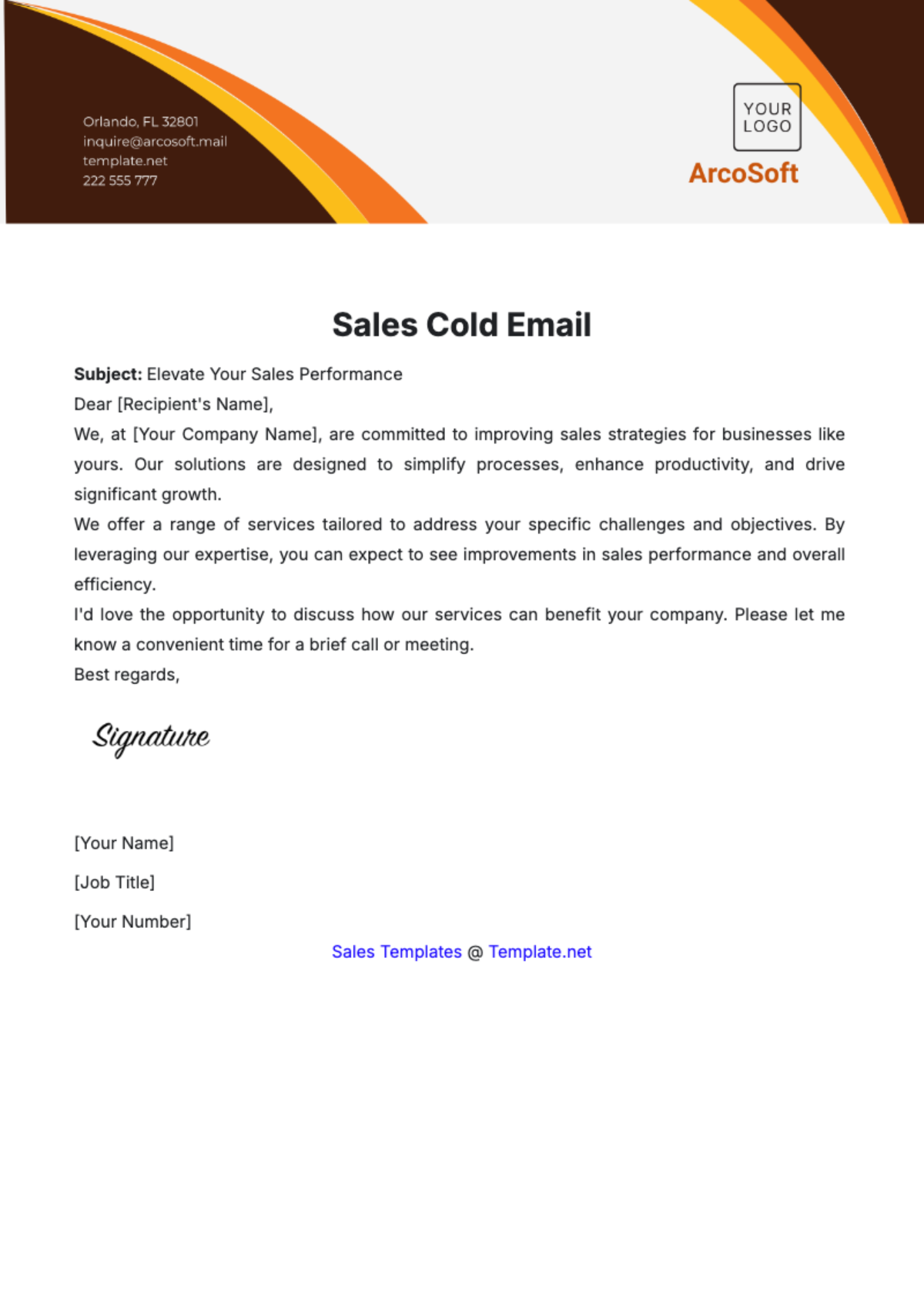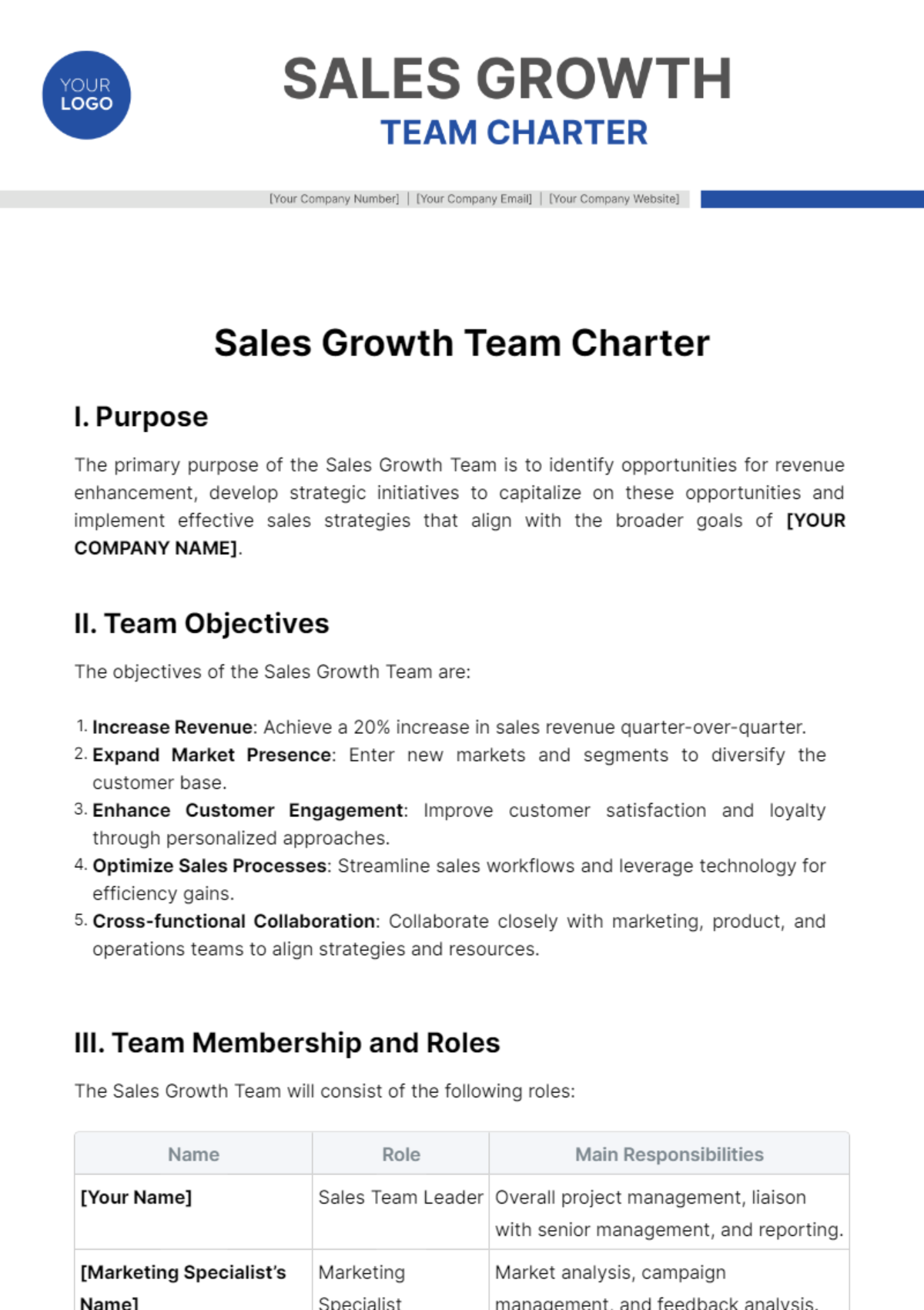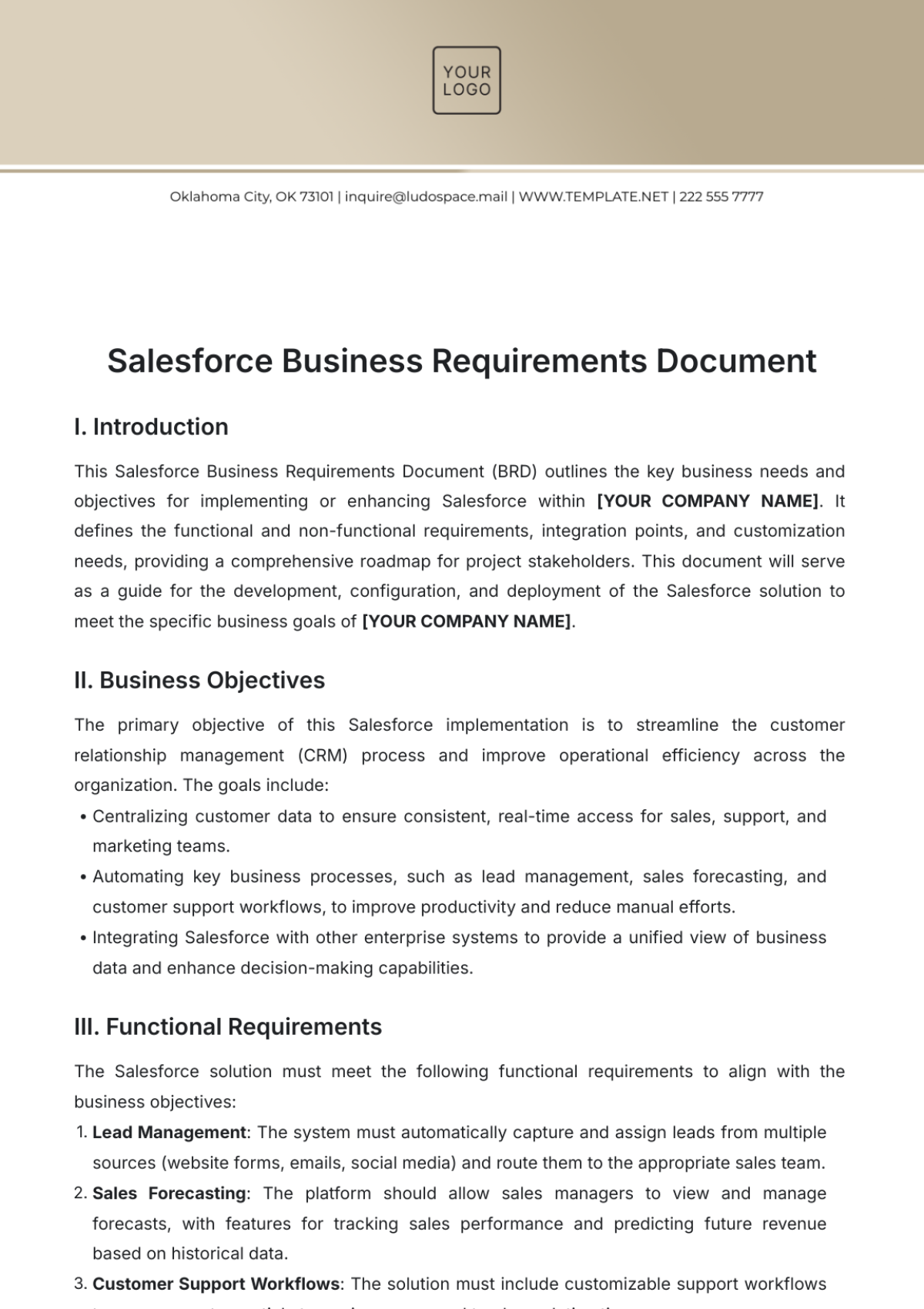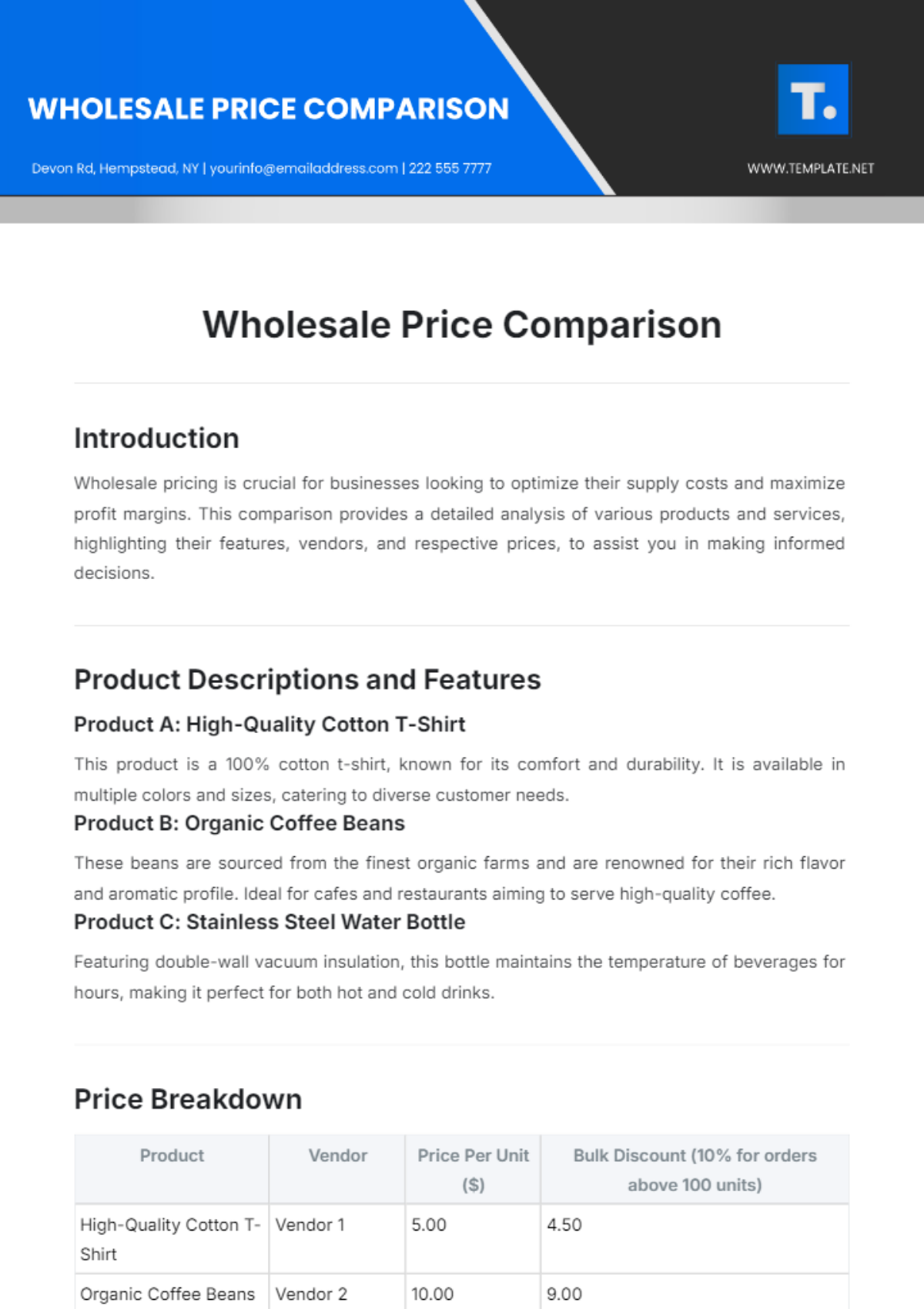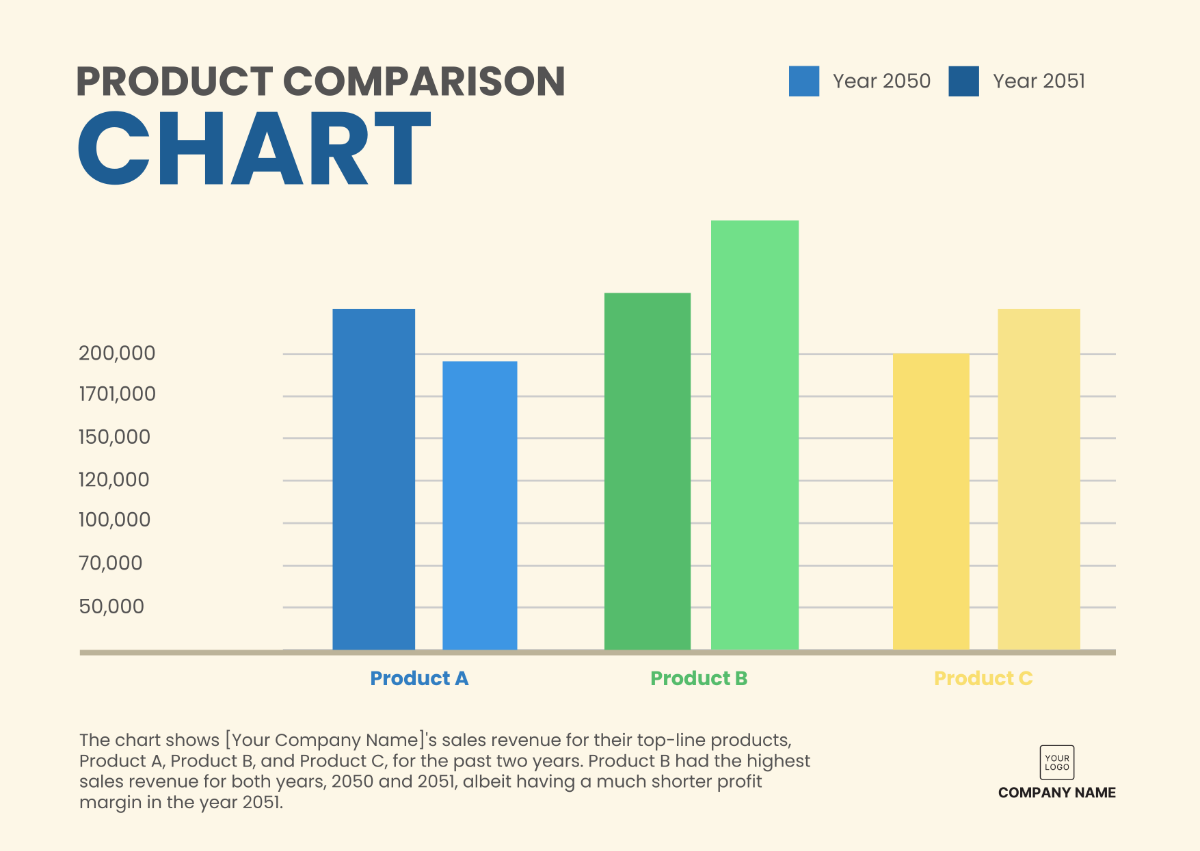Sales Feasibility Study on Implementing
New Metrics
A. Introduction
Sales operations serve as the frontline in achieving a company's financial objectives, making it crucial to have a comprehensive and adaptive performance evaluation system in place. The purpose of this feasibility study at [Your Company Name] is to critically examine the effectiveness of the current sales metrics and propose enhancements that can lead to more targeted performance assessments and, consequently, a more streamlined sales operation.
By applying a multi-faceted approach to evaluate various aspects such as initial and ongoing costs, anticipated advantages, potential disadvantages, and logistical requirements for implementing new sales metrics, this study aims to present a holistic view. The intended audience for this document includes the senior management team, sales operations managers, and any stakeholders interested in optimizing the company's sales performance.
B. Executive Summary
This feasibility study is designed to thoroughly assess the practicality, costs, benefits, and risks associated with implementing a new set of sales metrics at [Your Company Name]. The primary objective is to optimize sales operations by adopting key performance indicators (KPIs) that align closely with the organization's strategic objectives, both short-term and long-term. The study covers various facets such as a detailed cost analysis, expected benefits, risk evaluation, and a step-by-step implementation timeline.
C. Current Scenario
The sales operations at [Your Company Name] are currently guided by a set of performance metrics that were established several years ago. While these metrics have served the company adequately in the past, there is a growing consensus that they may not be entirely aligned with the company's current objectives and the modern sales landscape. As part of the overall sales strategy, it is vital to scrutinize these existing metrics to understand how well they meet our current needs, and where they fall short.
Current Metrics Employed:
Current Metrics
Revenue Generated: This metric measures the aggregate sales revenue generated by each sales representative within a defined period. Although comprehensive in capturing top-line performance, it does not differentiate between types of revenue, such as new sales versus renewals, or high-margin versus low-margin sales. As a result, it can sometimes reward behaviors that are not in line with the strategic focus of the organization.
Number of Deals Closed: This metric counts the total number of sales deals that have been successfully closed. While this offers a straightforward view of sales activity, it fails to account for the qualitative aspects of these deals. For instance, closing a large number of low-value deals might be less beneficial for the company compared to securing a few high-value contracts.
Customer Retention Rate: This metric evaluates the percentage of customers who continue to do business with us over a specific period, usually calculated annually. While this provides valuable information about customer satisfaction and loyalty, it does not capture the full scope of customer engagement. It can overlook aspects like the upsell or cross-sell opportunities and the varying value a retained customer may bring over time.
Issues with Current Metrics
Lack of Focus on Customer Lifetime Value: The existing metrics heavily emphasize immediate revenue generation but do not account for the long-term value a customer may bring, leading to short-term strategies that may not be beneficial in the long run.
No Measurement for Sales Cycle Time: There is currently no metric to measure the duration of the sales cycle, which could provide insights into the efficiency of the sales process.
Neglect of Upselling and Cross-Selling Opportunities: The current metrics do not track or incentivize upselling and cross-selling, both of which are increasingly important in maximizing revenue per customer.
Inflexibility in a Dynamic Market: The set metrics do not adapt well to changing market conditions, potentially leading to performance evaluations that are not reflective of actual market challenges.
Resource Misallocation: The heavy focus on just revenue and deal counts could lead to resource allocation that doesn't necessarily align with strategic growth areas such as new markets or product lines.
Benchmark Analysis
To better understand the limitations of our current metrics, a comparison was made with industry standards and competitor practices. The analysis revealed that most industry peers have already moved towards a more balanced set of metrics that include customer satisfaction scores, the rate of lead conversion, and sales representative responsiveness among other factors.
Current Scenario Assessment
In light of the aforementioned points, it becomes increasingly clear that the existing metrics are in need of a comprehensive review and likely, a revision. While they have contributed to past successes, they appear to be less aligned with current company goals and modern sales best practices.
D. Proposed New Metrics
The need for redefining the current sales metrics at [Your Company Name] arises from several limitations identified during the assessment of the current scenario. The new set of proposed metrics is engineered to provide a balanced view of sales performance that integrates both short-term accomplishments and long-term strategic alignment. These redesigned key performance indicators (KPIs) are aimed to offer actionable insights, drive optimal behaviors among sales representatives, and align sales activities more closely with the overarching organizational objectives.
Proposed New Metrics:
New Metrics
Revenue Generated: While the current metric measures total sales revenue, this refined version will segment the revenue based on different market segments, types of customers, and product categories. This allows for a more nuanced understanding of where revenue is coming from, facilitating targeted strategy adjustments.
Customer Lifetime Value (CLV): Introducing this metric shifts the focus from just immediate revenue to long-term customer value. It considers the net profit attributed to the entire future relationship with a customer, thereby promoting long-term customer retention strategies.
Sales Cycle Time: This new metric measures the average time taken from the initial contact with a potential customer to closing the deal. Shorter sales cycles are generally more cost-effective and indicative of a well-honed sales process.
Upselling Rate: This metric evaluates the effectiveness of efforts to sell more expensive versions of products or additional features to existing customers. It serves as an indicator of both sales skill and customer satisfaction.
Cross-selling Rate: This measures how often sales representatives can sell complementary products or services to existing customers. High cross-selling rates not only boost revenue but also deepen customer relationships.
Advantages of Proposed New Metrics
The new metrics offer a more comprehensive understanding of sales performance, going beyond merely counting revenue or deals.
They are designed to align closely with the broader business strategy, thus driving activities that contribute to long-term success.
By providing a detailed breakdown of revenue sources, sales cycle times, and upsell/cross-sell rates, the new metrics facilitate better resource allocation.
The proposed metrics are intended to encourage sales representatives to engage in activities that align with organizational objectives, such as focusing on high-value customers or effectively upselling and cross-selling.
These metrics can be adapted or modified easily as the business grows or the market changes, offering a certain degree of future-proofing.
By implementing these proposed new metrics, [Your Company Name] expects to create a more effective, accountable, and agile sales evaluation system. This move is anticipated to foster a culture of continuous improvement and strategic alignment within the sales department.
E. Cost Analysis
The purpose of this cost analysis is to provide an exhaustive evaluation of the financial requirements associated with implementing the proposed new sales metrics at [Your Company Name]. This includes not only the initial setup costs but also any ongoing expenditures that would be required to maintain and adjust these metrics effectively.
Category | Initial Cost | Annual Recurring Costs |
|---|---|---|
Software Updates | $10,000 | $2,000 |
Cost-Benefit Analysis
To ascertain the financial viability of implementing the new metrics, a cost-benefit analysis has been conducted. The anticipated benefits include a 15% increase in sales effectiveness, a 10% improvement in customer retention, and an estimated 20% rise in upselling and cross-selling opportunities. When converted to monetary terms based on the previous year's revenue, these benefits significantly outweigh the associated costs.
Risk Mitigation
It's crucial to note that any cost analysis comes with its set of risks. Budget overruns and unanticipated complications can inflate costs. To mitigate these risks, a contingency fund of 10% of the total estimated initial costs has been proposed.
Based on the detailed evaluation, the total initial cost for implementing the new metrics is estimated at $25,000, with an annual recurring cost of $15,000. The benefits, both tangible and intangible, appear to significantly outweigh these costs, thereby making the implementation of the proposed metrics financially justifiable. A thorough plan for risk mitigation is also in place to account for any unforeseen expenditures.
F. Implementation Timeline
The implementation timeline provides a structured plan for the deployment of the proposed new sales metrics at [Your Company Name]. This section outlines the key milestones, associated deadlines, and responsible parties for each phase of the implementation process.
Phase | Start Date | End Date |
|---|---|---|
Phase 1: Planning and Assessment | [Month, Day, Year] | [Month, Day, Year] |
Milestones
Phase 1: Planning and Assessment
Finalize the set of new metrics
Conduct a readiness assessment
Develop an initial project plan
Phase 2: Software and Tools Setup
Procure or update required software
Customize analytics tools
Test the system for bugs and security vulnerabilities
Phase 3: Training and Onboarding
Develop training modules
Conduct training sessions
Validate the understanding and preparedness of the sales team
Phase 4: Rollout and Monitoring
Full-scale implementation of the new metrics
Ongoing monitoring and adjustments
Quarterly performance reviews based on new metrics
Risks and Contingencies
Implementation may face challenges like delays, budget overruns, or unexpected technical issues. A contingency plan, complete with alternative courses of action, will be prepared to mitigate these risks.
The proposed timeline serves as a strategic framework for implementing the new sales metrics at [Your Company Name]. Each phase is meticulously planned to ensure that all aspects, from software updates to training and full-scale rollout, are executed within the set time frames.
G. Conclusion
The implementation of new sales metrics at [Your Company Name] seems feasible based on the cost-benefit analysis, and the proposed timeline is achievable. However, careful attention must be paid to the potential risks, including staff resistance and an initial decline in performance.
This study recommends moving forward with the implementation, beginning with securing management approval and allocating the necessary budget. For any queries related to this feasibility study, please contact the Sales Operations Team at [Your Company Number] or [Your Company Email].




